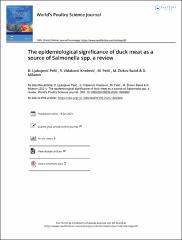| dc.contributor.author | Ljubojević Pelić, Dragana | |
| dc.contributor.author | Vidaković Knežević, Suzana | |
| dc.contributor.author | Pelić, Miloš | |
| dc.contributor.author | Živkov-Baloš, Milica | |
| dc.contributor.author | Milanov, Dubravka | |
| dc.date.accessioned | 2021-02-02T09:43:29Z | |
| dc.date.available | 2021-02-02T09:43:29Z | |
| dc.date.issued | 2021-01 | |
| dc.identifier.citation | D. Ljubojević Pelić , S. Vidaković Knežević , M. Pelić , M. Živkov Baloš & D. Milanov (2021): The epidemiological significance of duck meat as a source of Salmonella spp. a review, World's Poultry Science Journal, DOI: 10.1080/00439339.2020.1866960 | en_US |
| dc.identifier.issn | 0043-9339 | |
| dc.identifier.uri | https://repo.niv.ns.ac.rs/xmlui/handle/123456789/322 | |
| dc.description.abstract | Foodborne transmission of Salmonella spp. from contaminated duck
meat has been recognised as an important hazard for human health
in the past few decades and pathogenic strains of Salmonella spp.
have long been considered as serious zoonotic hazards. The nutritional quality is the main reason for the fact that duck meat is very
attractive for consumers worldwide, so measures to preserve the
safety of duck meat are very important. Duck meat has received little
attention in epidemiological studies, but undoubtedly the consumption of contaminated duck meat poses a high risk of foodborne
disease just like other types of poultry meat and reports showed
that 2% of all foodborne outbreaks were associated with consumption of duck meat. Furthermore, some results showed that contamination of duck meat with Salmonella spp. was 29.9% and was the
highest in comparison with chicken (5%), turkey (5%) as well as meat
of other poultry species. Prevalence of Salmonella spp. on duck farms
in different countries significantly varied with time, ranging from 3.3%
to 66.7%. The widespread use of antibiotics could be a significant
cause in the development and transmission of resistance determinants from duck to humans via the food chain. The relationship
between duck meat and the occurrence of salmonellosis in humans,
mainly due to the lack of proper regulations, is reviewed in the
present paper. The need for regular control of the presence of
Salmonella in ducks, their environment and duck meat is highlighted.
Continuous monitoring and reporting on incidents in the future
should improve the current regulations. | en_US |
| dc.description.sponsorship | This work was financially supported by a grant from the Ministry of Education, Science and Technological Development, Republic of Serbia, Project number TR 31071. | en_US |
| dc.language.iso | en | en_US |
| dc.publisher | Taylor & Francis | en_US |
| dc.source | World's Poultry Science Journal | en |
| dc.subject | Zoonotic pathogen | en_US |
| dc.subject | Salmonella spp. | en_US |
| dc.subject | monitoring | en_US |
| dc.subject | duck meat | en_US |
| dc.subject | food safety | en_US |
| dc.title | The epidemiological significance of duck meat as a source of Salmonella spp. a review | en_US |
| dc.type | Article | en_US |
| dc.identifier.doi | 10.1080/00439339.2020.1866960 | |

